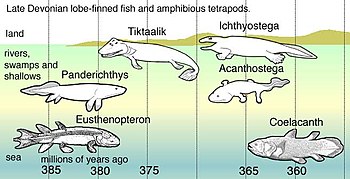Missing Links, Transitional forms and the Fishapod

Paleontology hit the headlines a couple of months ago when paleontologists discovered a fossil fish, Tiktaalik roseae, that showed the beginnings of digits, wrists, elbows and shoulders, as well as a skull, neck and ribs that resemble those of tetrapods like today's familiar four-legged land animals. Paleontologists suggest that it was an intermediate form between fish which lived about 385 million years ago, and early tetrapods which lived about 365 million years ago. Its mixture of fish and tetrapod characteristics led one of its discoverers, Neil Shubin, to characterize Tiktaalik as a "fishapod". Like any self-respecting Fossil Tiktaalik has its own homepage.
The story raised some interesting debate about what is meant by the term 'missing link' - a term that sees more use in the mainstream media than the scientific literature. A better term would be 'transitional form'. The Wikipedia article on Transitional Forms has a nice set of figures showing the number of Hominin species known to science in 1850, 1900, 1950 and 2002 - illustrating how our knowledge has steadily increased and although there are still 'gaps' in the record these gaps become smaller and smaller through time.
A popular term to designate transitional forms with is 'the missing link'. The term is especially used in the regular media, but is inaccurate and confusing. This is partly because it implies that there was a single link missing to complete the picture, which now has been discovered. In reality, the continuing discovery of more and more transitional fossils is further adding to our knowledge of evolutionary transitions.
Labels: Paleontology
0 Comments:
Post a Comment
<< Home